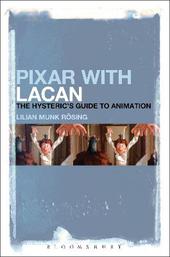
|
Pixar with Lacan: The Hysteric's Guide to Animation
Hardback
Main Details
| Title |
Pixar with Lacan: The Hysteric's Guide to Animation
|
| Authors and Contributors |
By (author) Lilian Munk Roesing
|
| Physical Properties |
| Format:Hardback | | Pages:192 | | Dimensions(mm): Height 229,Width 152 |
|
| Category/Genre | Film theory and criticism
Animated films |
|---|
| ISBN/Barcode |
9781628920598
|
| Classifications | Dewey:791.4334 |
|---|
| Audience | | Tertiary Education (US: College) | |
|---|
| Illustrations |
15 bw illus
|
|
Publishing Details |
| Publisher |
Bloomsbury Publishing Plc
|
| Imprint |
Bloomsbury Academic USA
|
| Publication Date |
17 December 2015 |
| Publication Country |
United States
|
Description
The films from Pixar Animation Studios belong to the most popular family films today. From Monsters Inc to Toy Story and Wall-E, the animated characters take on human qualities that demand more than just cultural analysis. What animates the human subject according to Pixar? What are the ideological implications? Pixar with Lacan has the double aim of analyzing the Pixar films and exemplifying important psychoanalytic concepts (the voice, the gaze, partial object, the Other, the object a, the primal father, the name-of-the-father, symbolic castration, the imaginary/ the real/ the symbolic, desire and drive, the four discourses, masculine/feminine), examining the ideological implications of the images of human existence given in the films.
Author Biography
Lilian Munk Roesing is Associate Professor in the Department of Arts and Cultural Studies at University of Copenhagen, Denmark, and a literary critic. In the fields of aesthetics and psychoanalytic cultural criticism, Roesing has published (in Danish) Reading the Child, The Catechism of Genderand The Return of Authority.
ReviewsWhat makes the book so charming is its humor, and its absolute commitment to Pixar's films as important contributions to modern man's self-understanding. * Dixikon (Bloomsbury translation) * Everyone has always felt that Pixar films revolutionized animation, and this revolution seemed due simply to technological and narrative inventiveness. With the appearance of Lilian Monk Roesing's Pixar with Lacan, we now know the true reason for the Pixar revolution. The greatness of Pixar films stems directly from their profound engagement with Lacanian theory. The animation that Pixar creates is, as Roesing shows, the animation of the subject itself. Through a series of groundbreaking readings of all the major Pixar films, Roesing provides us with the definitive account of the reason for the Pixar revolution. If we watch Pixar films closely enough, we will have in ready to hand all the central concepts of Lacan theory, and Roesing shows us this is a breathtaking fashion. * Todd McGowan, Associate Professor of Film and Television Studies, University of Vermont, USA, and author of The Real Gaze: Film Theory After Lacan * I found the book imaginative, engaging and unusually perceptive about the linkage of Pixar's animation to what drives us psychologically, economically and ideologically. Munk Rosing takes on all of Pixar's films, from Toy Story to Up!, demonstrating her depth of knowledge of the techniques and innovations in animation that she then analyzes beautifully by the light of psychoanalytic theory after Freud and Lacan. This is a tour de force, a must-read for all students of contemporary culture. * Juliet Flower MacCannell, Professor Emerita of English and Comparative Literature, University of California, Irvine, USA *
|